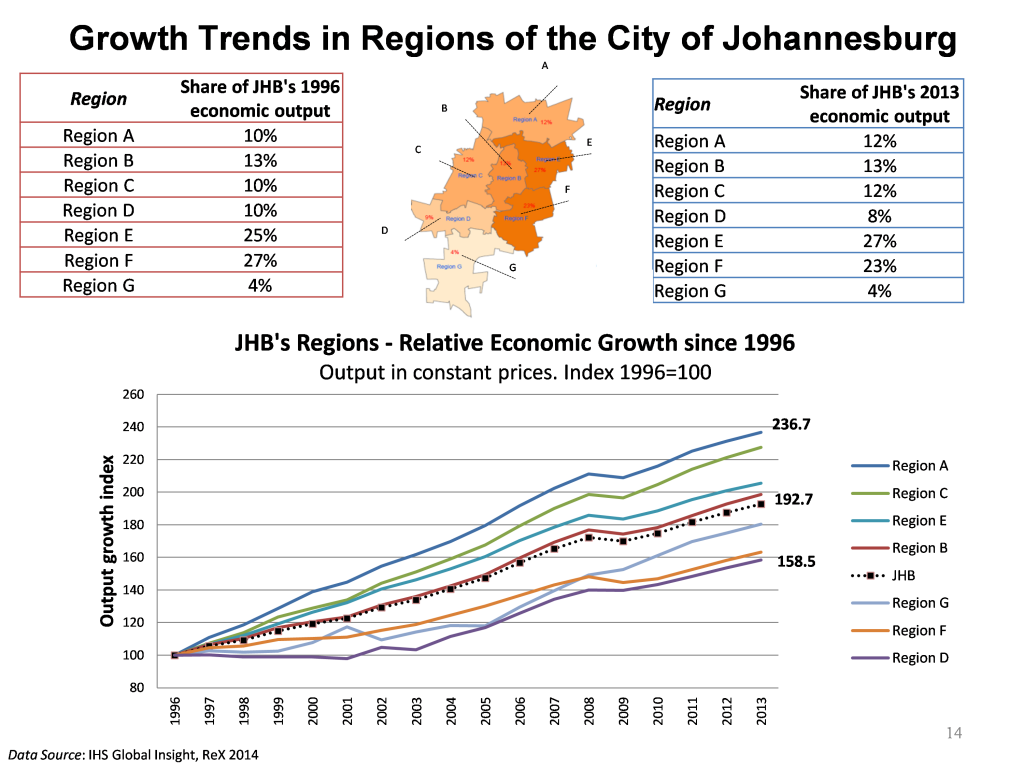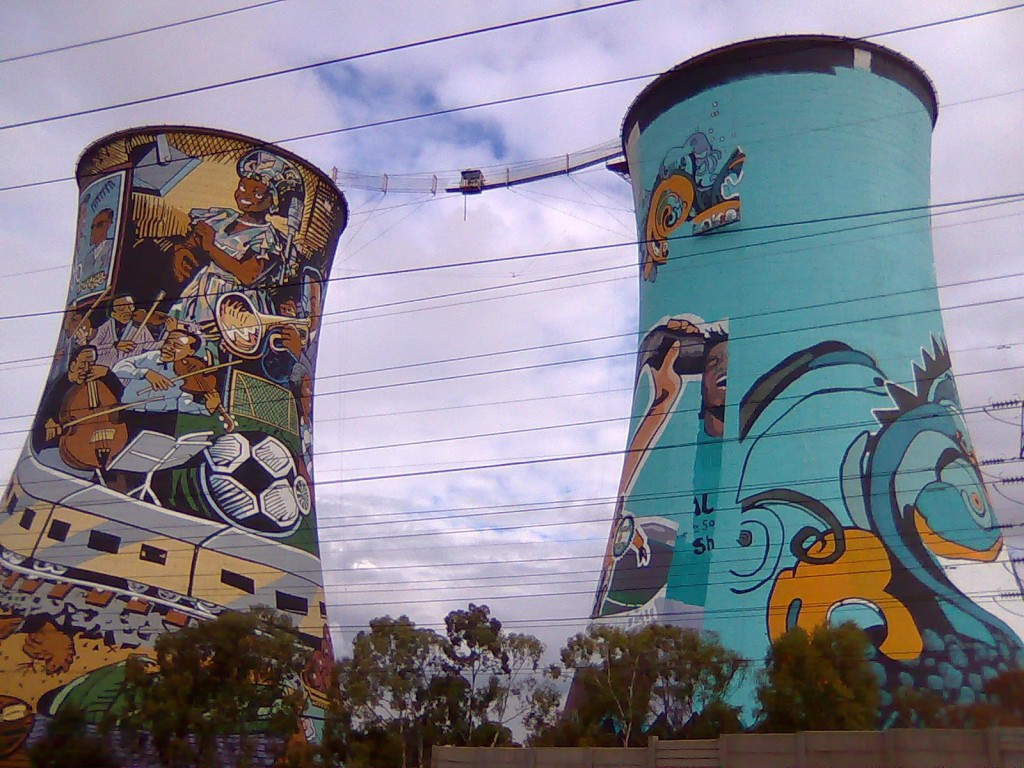- Overview
- Growth Trends
- Contact
- In 2013, two adjoining regions in the eastern half of the city were responsible for 50% of the City’s output – Region E (27%) which is dominated by the financial hub of Sandton and Region F (23%) which is the Inner City and traditional Central Business District. The regions along the northern and western edge of the city – Regions B (including the Westcliffe, Rosebank and Randburg), Region A (including Midrand) and Region C (including the industrial areas of Roodepoort) accounted for 37% of output. The regions in the south west and south – Regions D (8%) and Region G (4%) which include Soweto, Lenasia, Ennerdale and Orange Farm despite housing a large proportion of the population, only contribute some 13% to output in the economy.
- The level of output in all regions in the City grew significantly between 1996 and 2013. However the regional variation in growth is large, with the four regions in the northern half of the city growing the fastest. Output more than doubled in Region A (136%), Region C (127%) and Region E (105%) and, nearly doubled in Region B (98%). Growth in the three regions in the southern half of the city lagged behind however – Region G (80%), Region F (63%) and Region D (58%).

Johannesburg is a cosmopolitan city in South Africa’s hinterland situated in the populous largely metropolitan Gauteng Province. Founded on the discovery of gold on the Witwatersrand range some 130 years ago, a mining boom saw the City become the focal point of South Africa’s economy. The discovery of gold drew a flood of entrpreneurs seeking livelihoods and fortunes from far and wide. For most its history, Johannesburg has remained a magnet for people seeking opportunity and the chance for a better life. A mining-finance complex, mining support industries and a diversified range of other economic activities to service growing industries and a rapidly expanding population, quickly developed in the City and its adjoining towns.
Over the past eighteen years Johannesburg’s economy has grown faster than that of South Africa as a country. The result of this performance is a City output which in 2013 was some 92 percent larger than in 1996 – compared with the 70 percent for South Africa as a whole. This in relative terms, favourable economic performance, is also reflected in employment statistics, where despite inwards migration, the City had in 2013, a higher proportion of working age people in employment than any other South African City.
The City remains the most populous in the country, in 2013 being home to an estimated 4.6 million of the Gauteng Province’s 12.7 million residents. Johannesburg is the capital city of Gauteng Province. Post 1994, migration to the City from South Africa’s rural towns and settlements and from other countries, especially in Africa has accelerated, bringing both benefits and challenges.

Mandela Bridge
From a spatial perspective, Johannesburg’s economy comprise of seven diverse City regions. Certain striking features are evident from the data in the accompanying tables and graph.
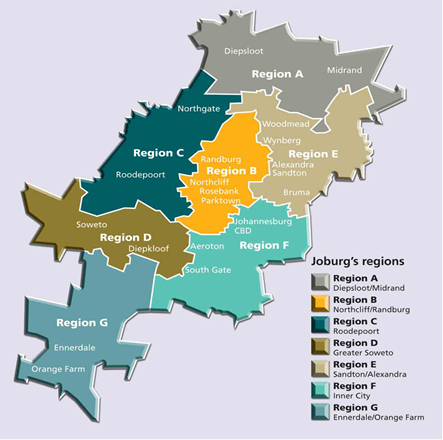
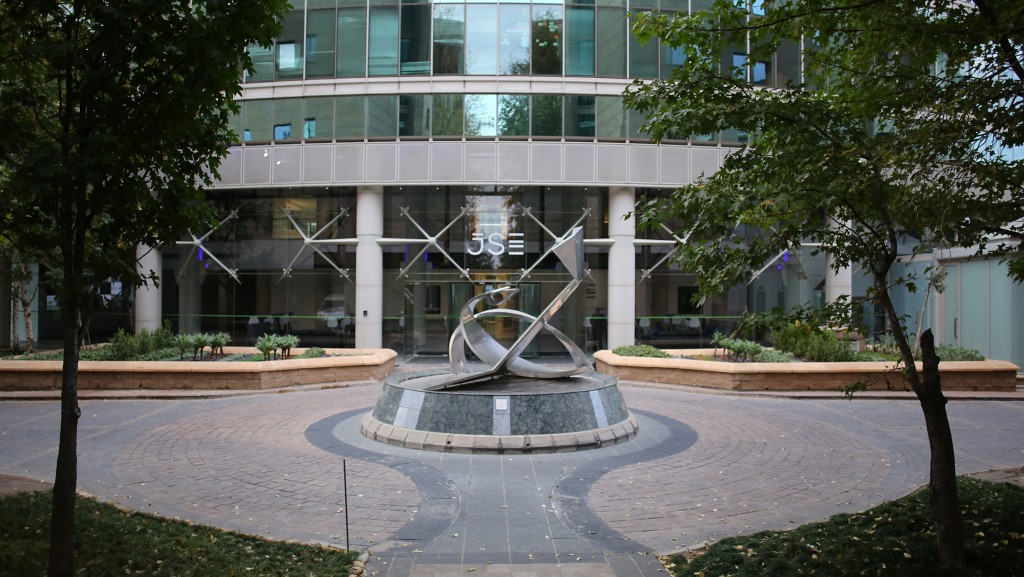
JSE, the largest stock exchange in Africa
At the 2015 State of the City address (SOCA) the Executive Mayor of the City of Johannesburg stated that “A City that knows it must change challenges into opportunities. That understands its destiny I determined by its capacity to innovate in order to transform. A City in which today is better than yesterday; which every day finds new ways to work with its people to ensure that tomorrow will be better than today”. The Mayors message focused on ‘turning challenges into opportunities’.
The Executive Mayor articulated that ‘We are a city where the young lead the call for transformation, demanding the opportunity to work, to improve their lives, and becoming the best of what they can be. A City that knows that with just a little help, our youth are not the challenge some think them to be, but our greatest asset’.
The urgency of achieving faster economic growth and accelerating job creation in the City economy is emphatically underscored by this aggregate data. Without faster economic growth and significantly increased job creation the livelihoods necessary to address poverty and inequality will not be forthcoming. Although progress has been made, in 2013 it is estimated that 1.5 million people or 33 percent of the population of the City of Johannesburg still live below the upper poverty line underlining the urgency with which the country is seeking to expedite economic progress.
Foundations of an Economic Development Strategy for Johannesburg: Transformation and Economic Growth Imperatives
Economic development has a key role to play in addressing Johannesburg’s social, economic and spatial challenges Poverty and unemployment, household service delivery backlogs, and the spatial legacy of City apartheid-era dysfunction and racial segregation, are all challenges which ultimately need to be addressed through economic development. A core requirement for sustainable progress is a pattern of economic growth which ultimately results in more and better quality jobs, generates rising incomes and better livelihoods for citizens and provides sustainable revenue growth for Government. The latter is important to allow the City to continue, improve and expand on service delivery.
The first building block in developing an economic strategy to meet Johannesburg’s development challenges is recognition of the need for deep-seated transformation in at least five dimensions.
An industrial transformation is being pursued to reverse the de-industrialisation of Johannesburg’s economy and to establish new industries. The powerful potential for development of economic linkages and the employment multipliers implicit in industrial and manufacturing sector development are an important part of the solution in meeting the socio-economic challenges of job creation, better livelihoods and better quality work in the long term.
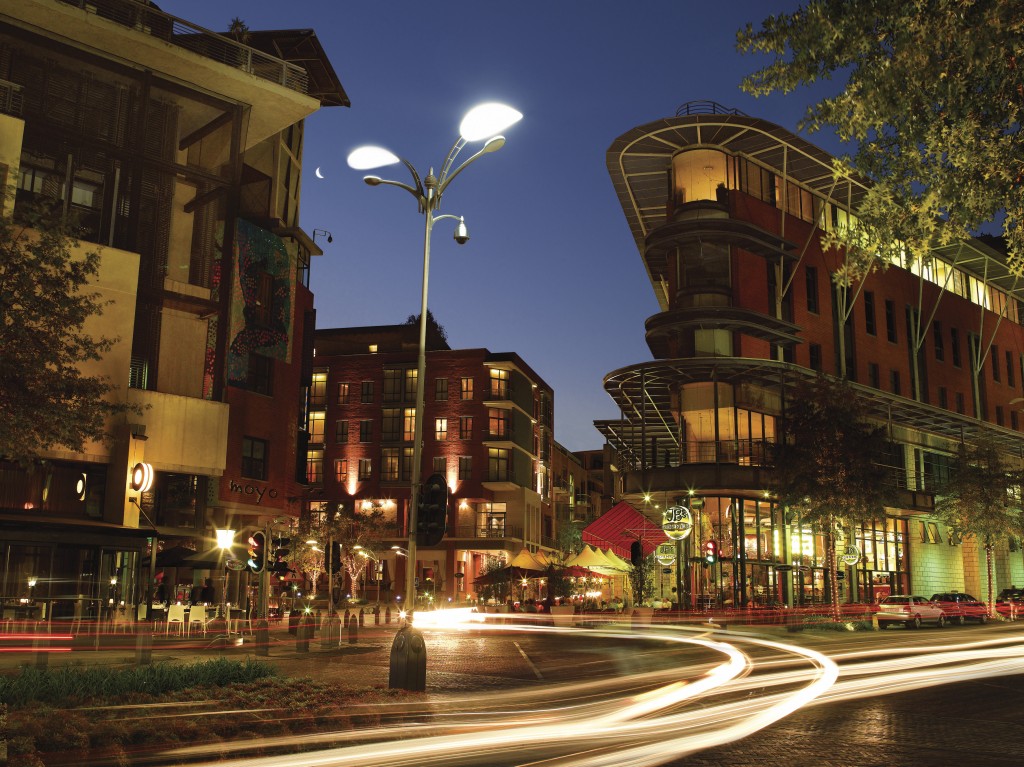
Melrose Arch
Spatial transformation is being followed to normalise the City’s functioning and build a unified identity. The undesirable spatial planning legacy of apartheid needs to be addressed and the spatial efficiency and economic competitiveness of the City needs to be improved in such a way as to better the quality of life of its citizens. Urban regeneration, stimulating existing and activating new economic growth nodes and development corridors, and ensuring mobility of people will contribute to improved economic activity and better quality of life. Urban regeneration and economic growth will also ultimately translate into higher property values and stronger revenue and sustainability for City authorities.
Global identity transformation is being pursued to strategically re-position the City economy to enable it to attract investment and anchor it in global and regional manufacturing and services sector value chains. ICT and Green Economic sectors are being chartered through the development of relevant Knowledge Precincts in the City.
Competitive market transformation is being mapped through the focus on initiatives to facilitate expansion and survival of the small business sector. This sector, is a key agent in broadening opportunity, creating jobs and building the economic resilience which can progressively address poverty and reduce inequality.
Finally, institutional transformation is an ever necessary requirement to facilitate better alignment of public and private sector and civil society bodies and institutions with economic development and growth imperatives. Positive alignment with mutually beneficial dynamics is ultimately in the interest of all parties.
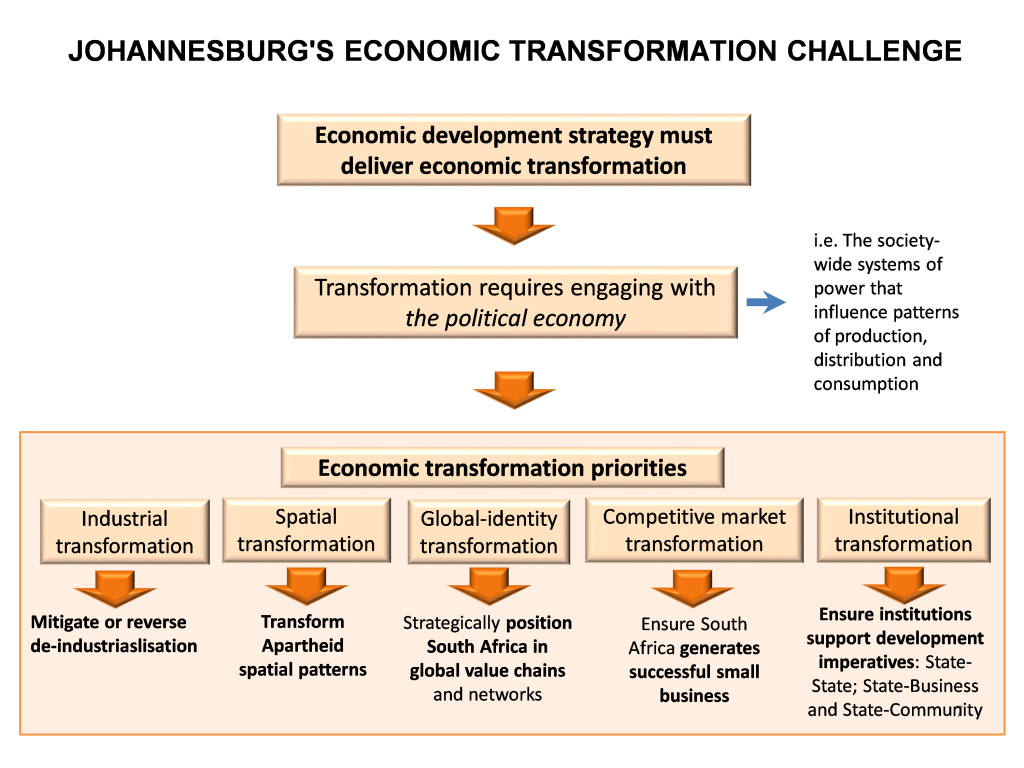
The second building block for City economic strategy is the recognition of the critical leadership and enabling role of the public sector in economic development and growth. National, provincial and local government each have a role to play in facilitating and guiding patterns of economic development in the collective interest and, in ensuring supportive conditions are in place to leverage private sector energies, competencies and resources in the local interest. However, it is ultimately the private sector and commercial state-owned enterprise sector which must deliver the output and jobs which generate livelihoods for citizens, tax revenues for government and export earnings for the country at large.
In the City, foundations are being put be in place for businesses, whether multinational conglomerates, large corporates, small and medium-sized enterprises or micro enterprises in the formal and informal sector to grow, develop and prosper. These include the development of priority zones, business hubs, and investment fast- tracking. The City has active forums to engage and form partnerships with local business and international investors.
 ‘Johannesburg – a world-class African City of the future – a vibrant, equitable African city, strengthened through its diversity; a city that provides real quality of life; a city that provides sustainability for all its citizens; a resilient and adaptive society.’ — Executive Mayor Cllr Mpho Parks Tau
‘Johannesburg – a world-class African City of the future – a vibrant, equitable African city, strengthened through its diversity; a city that provides real quality of life; a city that provides sustainability for all its citizens; a resilient and adaptive society.’ — Executive Mayor Cllr Mpho Parks Tau




